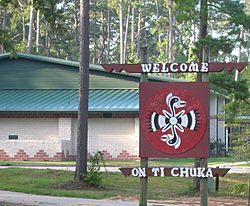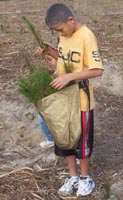Alabama people facts for kids
|
Alabama-Coushatta Reservation, Texas
|
|
| Total population | |
|---|---|
| 1,517 | |
| Regions with significant populations | |
380 enrolled members, Alabama-Quassarte Tribal Town |
|
| 1,137 enrolled members, Alabama-Coushatta Tribe of Texas | |
| Languages | |
| Originally Alabama however most now only speak English | |
| Religion | |
| Protestantism, traditional beliefs | |
| Related ethnic groups | |
| Coushatta, Hitchiti, Chickasaw, Choctaw, other Muscogee Creek people | |
The Alabama or Alibamu people are a group of Native Americans. They originally lived in the area that is now the state of Alabama. They were part of the Muscogee Creek Confederacy, which was a group of towns that worked together for trade and defense. Their traditional lands were along the upper Alabama River.
The Alabama people, along with their close allies, the Coushatta people, moved from Alabama and Mississippi. They migrated to the area of Texas in the late 1700s and early 1800s. This move happened because many European-American settlers were moving into their lands from the east. The Alabama and Coushatta tribes eventually joined together and shared land set aside for them.
Today, the Alabama–Coushatta Tribe of Texas is a federally recognized tribe. This means the United States government officially recognizes them as a sovereign nation. They have about 1,137 members and live on a reservation of about 4,500 acres (18 km²).
Another group, the Alabama–Quassarte Tribal Town, is also a federally recognized tribe. Their main office is in Wetumka, Oklahoma.
Contents
The Alabama Language
The Alabama language is part of the Muskogean language family. It is very similar to the Koasati language. It is also related to other languages like Chickasaw and Choctaw.
The Alabama language is also known as Alibamu. Today, about 100 people still speak the language. Most of these speakers live in Texas.
History of the Alabama People
The Alabama people first met Europeans in 1540. This was when the Spanish explorer Hernando de Soto traveled through their lands. Later, in the 1700s, the French arrived on the Gulf Coast. They built a fort in what is now Mobile, Alabama.
The Alabama and Koasati tribes were part of the Creek Confederacy. They did not have as much contact with British colonists as other Creek tribes did. When British colonists started settling in the region in the mid-1700s, the Alabama and Coushatta tribes were among the first to move away. This happened after the French gave up their land claims to the British following the Seven Years' War.
The Alabama and Coushatta tribes also wanted to avoid powerful Native American enemies like the Choctaw tribe. So, they moved into new areas, first into Louisiana and then into Texas.
Alabama and Coushatta towns were traditionally divided into "red" and "white" towns. The "white" towns were responsible for keeping peace and offering safety. The "red" towns were in charge of military actions. Even with these divisions, the Alabama-Coushatta people saw themselves as peaceful.
In 1795, the Coushatta arrived in the Big Thicket area of East Texas. By 1805, nearly 1,000 Alabama people came to Peach Tree Village in Tyler County, East Texas. The two tribes became good friends as they explored and hunted in their new home.
In the early 1800s, the Texas government gave each tribe some land along the Trinity River. However, European-American settlers soon took over this land, leaving the tribes without a home. Sam Houston, who was the governor of Texas, suggested that the state buy 1,280 acres (5 km²) for the Alabama tribe. Money was set aside to buy 640 acres (2.6 km²) for the Coushatta, but that land was never bought. Many Coushatta people moved to live on the land given to the Alabama, either by marriage or special permission. Other Coushatta stayed in southern Louisiana. Their descendants are now part of the federally recognized Coushatta Tribe of Louisiana.
By 1820, there were three main Alabama towns and three large Coushatta towns in East Texas. In 1854, the Alabama received 1,280 acres (5 km²) in Polk County. The next year, 640 acres (2.6 km²) in Polk County were given to the Coushatta. However, white settlers challenged the Coushatta's land claim in 1859. When the Coushatta lost their land, the Alabama invited them to live on their land.
In 1928, the federal government approved a large grant to buy more land near the reservation. This land was given to both the "Alabama and Coushatta tribes." Since then, the reservation has been officially known as "Alabama-Coushatta."
The Alabama and Coushatta tribes have stories about how they came to be. One story says that the two tribes grew from different sides of a cypress tree. Another legend from 1857 says they "sprang out of the ground between the Cohawba and Alabama Rivers." The symbol of the Alabama-Coushatta tribe shows two woodpeckers intertwined. This symbol comes from ancient Mississippian culture and now represents the strong connection between the two tribes.
Cultural Practices: Using Plants
The Alabama people have a long history of using plants for different purposes. For example, they used a specific type of plant called Pseudognaphalium obtusifolium. They would make a special tea from it to help with nervousness and sleepiness. They also used it as a face wash for nerves and trouble sleeping.
They had many other ways of using plants for medicine and daily life.
Contemporary Tribes Today
The Alabama-Coushatta Tribe of Texas
The Alabama people who moved to Texas supported Texas independence. Because of their help, Governor Sam Houston suggested that Texas buy land for the tribe. This happened after their original land was taken by settlers.
The Alabama and Coushatta tribes share many cultural traditions. They often married each other, and their languages come from the same family.
Today, they are known as the Alabama-Coushatta Tribe of Texas. For a long time, the state of Texas managed their lands. However, in 1987, the United States Congress officially recognized them as a federal tribe. This recognition meant they could not have certain types of gambling that were against Texas state laws at the time.
The tribe's lands are in eastern Polk County, Texas. The Alabama-Coushatta Indian Reservation is the oldest reservation in Texas. It covers about 7.137 square miles (18.484 km²). In 2000, about 480 people lived on the reservation. By 2010, there were about 1,000 members of the Alabama-Coushatta tribe.
The Alabama-Quassarte Tribal Town in Oklahoma
In Okmulgee County, Oklahoma, the Alabama–Quassarte Tribal Town was officially recognized by the federal government in 1936. The Alabama people who live there are also connected to the Muscogee Creek Nation, which is also federally recognized.
Tribal Economy and Gaming
In their earlier years in Texas, the Alabama-Coushatta Tribe made a living by gathering food, hunting, farming, fishing, and trading. In more recent times, the tribe has focused on services and entertainment to create jobs and income on their reservation.
In 2002, the tribe opened a convenience store, gas station, and tobacco store. These businesses are on U.S. Highway 190. Because the tribe is a sovereign nation, they can sell products without state taxes. This business has slowly become successful. It creates some jobs and a small profit for the tribe.
The tribe also opened an entertainment center for tourists. This center offered casino gambling. The tribe believed this was allowed because of a 1992 Texas law that permitted a state lottery, horse racing, and dog racing.
The entertainment center was very successful in creating jobs and income. It provided jobs for 87 tribal members, which greatly reduced unemployment from 46 percent to 14 percent. The money from the entertainment center helped the tribe fund important services. These included health care, programs for the elderly, education for young people, social services, and housing. These jobs also helped the local economy, as other businesses in the area reported more sales and tax income. The center created over 495 jobs in total and paid millions in wages.
After the center had been open for nine months, the state took legal action against it in 1999. A federal court decided that the Alabama-Coushatta had to close their entertainment center. This decision was based on the rules of their federal recognition in 1987, which did not allow gambling that was against state laws.
Without the casino, the tribe lost a major source of funding for their programs. More than 300 jobs were lost in Polk County. The Alabama-Coushatta tribe has been working to get support from the state and federal governments to reopen the entertainment center. They believe it would help the economy of both the tribe and the surrounding areas. Over the years, the tribe has worked hard to rebuild its economy in Polk County.
Daniel Inouye, a former United States senator from Hawaii, once said that discussions about Native American gaming are often about money. He believed that tribes should not face stricter rules than other citizens.
The Indian Gaming Regulatory Act (IGRA) was passed by the United States Congress in 1988. This law set up the rules for Native American gaming. The IGRA allows tribes to have casino-style operations. These operations can help improve government services and economic conditions in Native American communities.
According to the IGRA, tribes have the "exclusive right" to control gambling on their lands. This is true unless gambling is against federal law or if a state completely bans a type of gaming. The IGRA recognizes three types of gaming:
- Class I Gaming: This includes traditional tribal games, like stick and bone games.
- Class II Gaming: This includes games like bingo and pull tabs.
- Class III Gaming: This includes large-scale gambling operations, like casinos.
Tribes have full control over Class I gaming. Class II gaming is regulated by the tribes, with some oversight from the National Indian Gaming Commission. Class III gaming can be allowed in states that permit large-scale gambling. For Class III gaming, tribes and states must agree on rules in special agreements called "Tribal-State compacts." States are supposed to negotiate these agreements fairly. Without a Tribal-State compact, a tribal casino cannot operate.
The Indian Gaming Regulatory Act requires that money from gaming be used only for government services or charitable purposes. Tribal governments decide how this money is spent. It is often used to build things like housing, schools, and roads for tribal members. It also helps fund health care and education. Gaming revenues can also help tribes develop other businesses, such as museums, malls, and cultural centers. These businesses attract tourists and other visitors.
Native American gaming is seen as a very important way for tribes to develop their economies. It can provide significant economic benefits in states where tribes and states work together.
See also
 In Spanish: Alabama (tribu) para niños
In Spanish: Alabama (tribu) para niños



